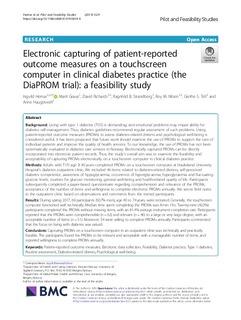| dc.contributor.author | Hernar, Ingvild | |
| dc.contributor.author | Graue, Marit | |
| dc.contributor.author | Richards, David A | |
| dc.contributor.author | Strandberg, Ragnhild Bjarkøy | |
| dc.contributor.author | Nilsen, Roy Miodini | |
| dc.contributor.author | Tell, Grethe S. | |
| dc.contributor.author | Haugstvedt, Anne | |
| dc.coverage.spatial | Norway, Bergen | nb_NO |
| dc.date.accessioned | 2019-03-21T14:48:47Z | |
| dc.date.available | 2019-03-21T14:48:47Z | |
| dc.date.created | 2019-02-21T18:42:41Z | |
| dc.date.issued | 2019 | |
| dc.identifier.citation | Hernar, I., Graue, M., Richards, D., Strandberg, R. B., Nilsen, R. M., Tell, G. S., & Haugstvedt, A. (2019). Electronic capturing of patient-reported outcome measures on a touchscreen computer in clinical diabetes practice (the DiaPROM trial): a feasibility study. Pilot and Feasibility Studies, 5(1). | nb_NO |
| dc.identifier.issn | 2055-5784 | |
| dc.identifier.uri | http://hdl.handle.net/11250/2591134 | |
| dc.description.abstract | Background
Living with type 1 diabetes (T1D) is demanding, and emotional problems may impair ability for diabetes self-management. Thus, diabetes guidelines recommend regular assessment of such problems. Using patient-reported outcome measures (PROMs) to assess diabetes-related distress and psychological well-being is considered useful. It has been proposed that future work should examine the use of PROMs to support the care of individual patients and improve the quality of health services. To our knowledge, the use of PROMs has not been systematically evaluated in diabetes care services in Norway. Electronically captured PROMs can be directly incorporated into electronic patient records. Thus, the study’s overall aim was to examine the feasibility and acceptability of capturing PROMs electronically on a touchscreen computer in clinical diabetes practice.
Methods
Adults with T1D age ≥ 40 years completed PROMs on a touchscreen computer at Haukeland University Hospital’s diabetes outpatient clinic. We included 46 items related to diabetes-related distress, self-perceived diabetes competence, awareness of hypoglycaemia, occurrence of hyperglycaemia, hypoglycaemia and fluctuating glucose levels, routines for glucose monitoring, general well-being and health-related quality of life. Participants subsequently completed a paper-based questionnaire regarding comprehension and relevance of the PROMs, acceptance of the number of items and willingness to complete electronic PROMs annually. We wrote field notes in the outpatient clinic based on observations and comments from the invited participants.
Results
During spring 2017, 69 participants (50.7% men), age 40 to 74 years, were recruited. Generally, the touchscreen computer functioned well technically. Median time spent completing the PROMs was 8 min 19 s. Twenty-nine (42.0%) participants completed the PROMs without missing items, with an 81.4% average instrument completion rate. Participants reported that the PROMs were comprehensible (n = 62) and relevant (n = 46) to a large or very large degree, with an acceptable number of items (n = 51). Moreover, 54 were willing to complete PROMs annually. Participants commented that the focus on living with diabetes was valued.
Conclusions
Capturing PROMs on a touchscreen computer in an outpatient clinic was technically and practically feasible. The participants found the PROMs to be relevant and acceptable with a manageable number of items, and reported willingness to complete PROMs annually. | nb_NO |
| dc.language.iso | eng | nb_NO |
| dc.publisher | BioMed Central | nb_NO |
| dc.relation.uri | https://pilotfeasibilitystudies.biomedcentral.com/articles/10.1186/s40814-019-0419-4 | |
| dc.rights | Navngivelse 4.0 Internasjonal | * |
| dc.rights.uri | http://creativecommons.org/licenses/by/4.0/deed.no | * |
| dc.subject | patient-reported outcome measures | nb_NO |
| dc.subject | electronic data collection | nb_NO |
| dc.subject | feasibility | nb_NO |
| dc.subject | diabetes practice | nb_NO |
| dc.subject | type 1 diabetes | nb_NO |
| dc.subject | routine assessment | nb_NO |
| dc.subject | diabetes-related distress | nb_NO |
| dc.subject | psychological well-being | nb_NO |
| dc.title | Electronic capturing of patient-reported outcome measures on a touchscreen computer in clinical diabetes practice (the DiaPROM trial): a feasibility study | nb_NO |
| dc.type | Journal article | nb_NO |
| dc.type | Peer reviewed | nb_NO |
| dc.description.version | publishedVersion | nb_NO |
| dc.rights.holder | © The Author(s) 2019. | nb_NO |
| dc.subject.nsi | VDP::Medisinske Fag: 700::Klinisk medisinske fag: 750::Endokrinologi: 774 | nb_NO |
| dc.source.pagenumber | 11 | nb_NO |
| dc.source.volume | 5 | nb_NO |
| dc.source.journal | BMC Pilot and Feasibility Studies | nb_NO |
| dc.source.issue | 29 | nb_NO |
| dc.identifier.doi | 10.1186/s40814-019-0419-4 | |
| dc.identifier.cristin | 1679720 | |
| cristin.unitcode | 203,11,1,0 | |
| cristin.unitname | Institutt for helse- og omsorgsvitskap | |
| cristin.ispublished | true | |
| cristin.fulltext | original | |
| cristin.qualitycode | 1 | |

